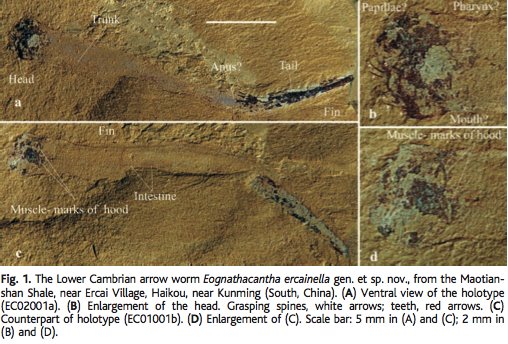Fossil History
The chaetognaths do not
have a very extensive fossil history, as they do not contain a mineralized
skeleton (Chen & Huang 2002, Szaniawski 2002). However, there has been one fossil
specimen found, Paucijaculum samamithion
(figure 1), which dates from the Carboniferous (360-286 MYA). More recently though,
Chen & Huang (2002) proposed that a second fossil chaetognath, Eognathacantha ercainella, may have been
found from the Lower Cambrian Maotianshan Shale (520 MYA). This specimen bares
similar features to modern chaetognaths, including three segments (head, trunk,
and possible tail), 12 grasping spines, possible teeth, and possibly a hood –
which is chaetognath synapomorphy. Despite these similarities, there are some differences
between E. ercainella and modern
chaetognaths, including: a narrow, non-rayed tail fin (c.f. wide, rayed tail
fin).
Other suggestions regarding
the evolution of chaetognaths are that they may be one of the earliest active predators,
and that their ancestor was probably planktonic, and lived in close associated
with the benthos (Harzsc et al. 2009).

Figure 1: Possible Lower Cambrian fossil Chaetognath. From Chen & Huang 2002. |